Executive Summary
- The median monthly salary for full-time Malaysian women employees was 97.9% that of their male counterparts in 2016. The gap is mainly due to non-discriminatory factors such as labour market structure
- In education and employment, men and women are constrained by traditional and cultural norms, and these result in pay inequality
- Women are more likely than men to work part-time and to take time out from their careers for family reasons
- The different approaches adopted by men and women when negotiating salaries, particularly the starting salary, is a telling example of the gender pay gap
- More social support and better family-friendly policies, including subsidised child care, can
go a significantly long way towards ensuring working women are paid fairly and are in a better position to support their families
Introduction
According to the Salaries and Wages Survey Report 2016, Malaysian women in employment were paid about 97.9% of what their counterparts earned on a monthly basis. [1]
This figure indicates that unlike developed countries like the US and the UK, the overall gender pay gap in Malaysia, at 2.1%, is very small. However, this is a raw pay gap that looked only at the median salary of those in employment irrespective of education attainment, job type, position and experience; and is inconsistent across industries, locations and ages.
The issue of gender pay gap is obviously a complex one, with many inter-related causes and therefore, requires detailed examination. In fact, the pay gap between men and women who work at similar jobs or are in the same industries becomes much more substantial when other comparisons are made.
Difference in Occupation
Education is no longer a factor in explaining the gender pay gap – more than half (63%) of university graduates in Malaysia are women. Figure 1 shows that women outnumber men in seven out of the eight main fields of study. However, the choosing of majors appears to contribute significantly to gender stereotyping of jobs, as well as wage discrepancy (Figure 2). Courses promising high-paying jobs like engineering are mostly male-dominated, while the social sciences, education and arts tend to be low-paying and female-dominated.
In employment, the five “Cs”: cleaning, cashiering, caring, clerical work and catering are taken up by poorly-paid women. Furthermore, due to traditional and cultural norms, women in Asia still face barriers in attaining managerial and C-Suite positions in companies; they are instead encouraged to pursue more feminine job types.
Figure 1: Number of student enrolments according to field of study and gender in Higher Education Institutions (HEIs) in Malaysia, 2014
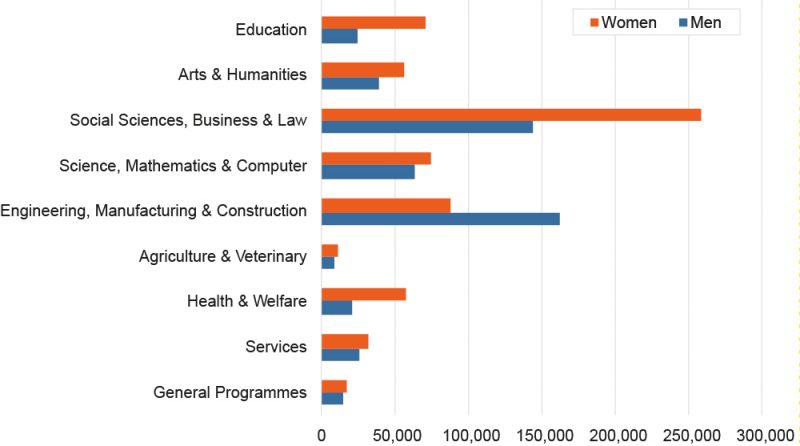
Note: The HEI category includes public universities, private higher education institutions, polytechnics and community colleges.
Figure 2: Employment by occupation and gender in Malaysia, 2016
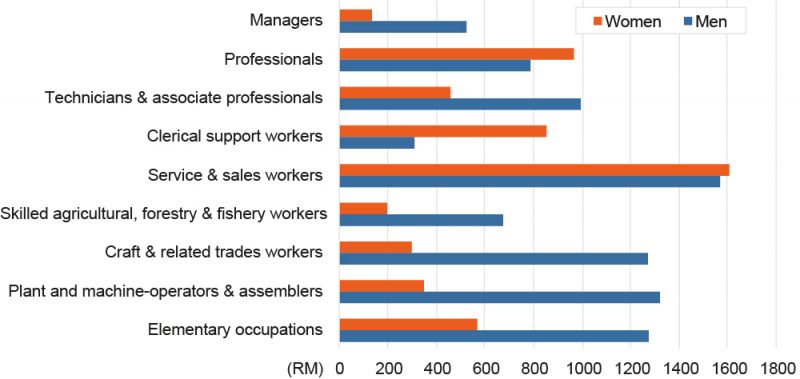
Note: Occupation is classified according to the Malaysia Standard Classification of Occupations (MASCO) 2013.
Likewise, women are paid less than men for the same work. A case in point: women in Malaysia hold more than half (55%) of “professional occupations”, yet their monthly salary is 14% lower, even in professions where men are outnumbered (Figure 3). [2] However, this does not necessarily indicate wage discrimination. It may be that within the same occupation, women occupy junior positions while men hold senior ones. As in many Asian countries, Malaysian working women are far less likely than men to be promoted to top management levels – this is mostly due to traditional and cultural barriers (Figure 4). Occupational segregation is therefore the result of both supply (men and women tending to choose different job types) and demand (e.g. glass ceiling for women to be promoted to senior positions).
Figure 3: The pay gap in median monthly salary by gender and occupation in Malaysia, 2016
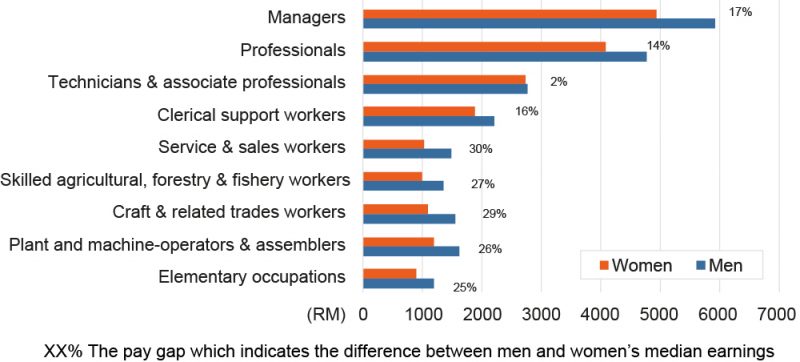
Figure 4: Proportion of women on top management teams across 13 Asian countries
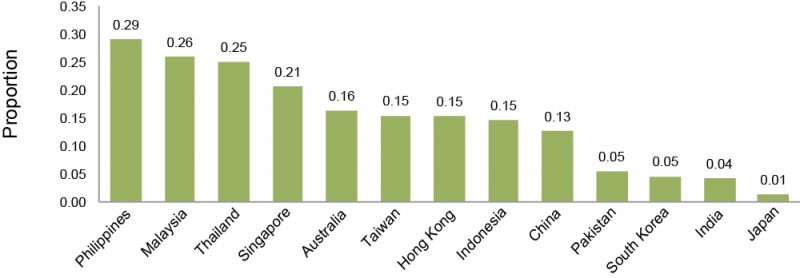
Insufficient Workplace Experience
In Malaysia full-time male employees work longer hours (48 hours) than their female counterparts (46 hours) on average. Women are more likely to work part-time than men – nearly
60% of part-timers in Malaysia are women – and to take time out from their careers for family reasons. According to the Labour Force Survey Report 2016, 32.3% of women who work part-time do so because of family responsibilities. In a study conducted by Universiti Malaya in 2015, of the 166 caregivers of the elderly with chronic illnesses studied, 63.3% of them were women, and were mainly daughters of the care recipients (Ghazali et al., 2015). Although working part-time enables women to better balance work, household and child care responsibilities, these jobs are often associated with lower wages and job security, and less training and promotion opportunities than full-time jobs (Garnero, 2016).
On average, women do more house and care work than men, especially in Asia where women are still expected to take sole responsibility for family and household duties, regardless of whether she works full-time or not. Research has shown that where women work fewer hours they do more housework; however, men do not vary their housework hours relative to working hours (Bianchi et al., 2000). It would seem that men’s longer working hours are facilitated by the women’s unpaid work, and this would contribute significantly to the widening of the gender pay gap.
The long hours needed for some of the highest-paying jobs are mismatched with gendered family responsibilities. The pay discrepancy between men and women would drop significantly if firms do not excessively reward individuals who work long and “particular” hours.
Older Women Face the Greatest Pay Gap
Women’s median monthly salary reaches its peak between the ages of 25 and 44. In higher age groups, the gender pay gap widens – women in their 50s and 60s earn about 23% and 30% less than their counterparts (Figure 5). This is probably linked to child-rearing and family responsibilities. Due to extra time spent in unpaid care work, women have fewer opportunities for career advancement and are less likely to hold high-paying jobs. In addition, older women, on average, have lower education attainment than younger women which would significantly impact their earning capabilities.
Figure 5: Median monthly salaries and wages of employees by age group and gender in Malaysia, 2016
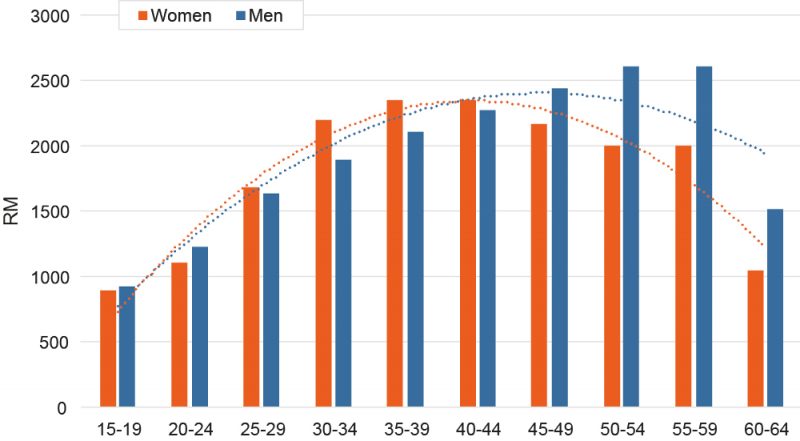
Women are Less Likely to Negotiate
Ambiguity about pay standards and confidentiality about salary, particularly for top positions, encourages potential candidates to negotiate further. However, research shows that women tend to negotiate less, especially for the starting salary (Small et al., 2007), while men are more likely to be successful in securing a higher pay. This lack of confidence and skill in negotiating is something that needs highlighting. It is important to note that when women do request for either a raise or higher starting salary, they are regarded as pushy and demanding, whereas men are seen as professional and assertive. The social cost is therefore greater for women as it violates prescriptive gender stereotypes derived from the gendered division of labour (Bowles and Babcock, 2013).
Employers should therefore consider developing transparent systems to assess the equal distribution of opportunities and rewards to all employees based on their skills and productivity.
Closing the Gender Pay Gap
To narrow the gender pay gap requires the dismantling of gender stereotypes in education and employment. Educational institutions should provide assistance and encouragement for female students to pursue typically male-dominated disciplines, and vice versa. In employment, the
practice of gender bias, especially in job promotions, needs to be addressed and promptly rectified. This can be achieved by helping women overcome traditional and cultural barriers, and advocacy for more social support for care work through publicly subsidised services. In fact, policies that allow both parents to balance work and family are fundamental in ensuring women’s work experiences and seniority are not penalised.
Additionally, both ends of the pay spectrum need to be considered, partly to tackle the glass ceiling effect, particularly on the highly-skilled women, and partly to ensure that both men and women are paid fairly and sufficiently for work that requires less skill.
References
Bianchi, S. M., Milkie, M. A., Sayer, L. C., & Robinson, J. P. (2000). Is anyone doing the housework? Trends in the gender division of household labor. Social forces, 79(1), 191-228.
Bowles, H. R., & Babcock, L. (2013). How can women escape the compensation negotiation dilemma? Relational accounts are one answer. Psychology of Women Quarterly, 37(1), 80-96.
Garnero, A. (2016). Are part-time workers less productive and underpaid?. IZA World of Labor. DOI: 10.15185/izawol.249
Ghazali, S. B., Abdullah, K. L., Aziz, A. B. A., Amin, R. B. M., Jusoh, A. S. B., Mansor, M. B., … & Shafie, Z. B. M. (2015). Burden of caregivers of the elderly with chronic illnesses and their associated factors in an urban setting in Malaysia. Malaysian Journal of Public Health Medicine, 15(1), 1-9.
Milli, J., Huang, W., Hartmann, H. & Hayes, J. (2017). The Impact of Equal Pay on Poverty and the Economy. Briefing Paper, Institute for Women’s Policy Research.
Small, D. A., Gelfand, M., Babcock, L., & Gettman, H. (2007). Who goes to the bargaining table? The influence of gender and framing on the initiation of negotiation. Journal of Personality and Social Psychology, 93(4), 600-613.
[1] The median monthly salary is used to measure the pay gap as it is less affected by extreme values, such as a relatively small number of very high earners. Moreover, the median gives a better indication of typical pay and inequality experienced by the majority of women. Hence, it is usually a better measure of the pay a typical worker receives. It is found that the pay gap based on the mean is higher than that of the median.
[2] The Salaries & Wages Survey Report 2016 does not detail which fields these professionals work in, and specific fields may display both a gender- and wage-skew.
Penang Institute has amended the following line under the subhead Older Women Face the Greatest Pay Gap: “For example, women in their 50s and 60s earn about 23% and 30% less than younger women (Figure 5)” to be read as “In higher age groups, the gender pay gap widens – women in their 50s and 60s earn about 23% and 30% less than their counterparts (Figure 5).”
Any inconvenience caused is much regretted.
Managing Editor: Ooi Kee Beng Editorial Team: Regina Hoo, Lim Su Lin, Nur Fitriah, Ong Wooi Leng
You might also like:
![Sustainable Strategies based on Penang Infrastructure Corporation's Projects]()
Sustainable Strategies based on Penang Infrastructure Corporation's Projects
![Investment Facilitation: A One-Stop Mechanism Needed to Assist Investors in Penang and Malaysia]()
Investment Facilitation: A One-Stop Mechanism Needed to Assist Investors in Penang and Malaysia
![Urgent Need to Strengthen Malaysia’s Legal Framework Against AI-Driven Scams]()
Urgent Need to Strengthen Malaysia’s Legal Framework Against AI-Driven Scams
![Perbandingan Hukuman Hudud untuk Kesalahan Sariqah dan Hirabah di Brunei, Aceh, Kelantan dan Terengg...]()
Perbandingan Hukuman Hudud untuk Kesalahan Sariqah dan Hirabah di Brunei, Aceh, Kelantan dan Terengg...
![Penang’s Next Economic Leap: Insights from Comparisons with Global Financial Centres in the Region]()
Penang’s Next Economic Leap: Insights from Comparisons with Global Financial Centres in the Region






